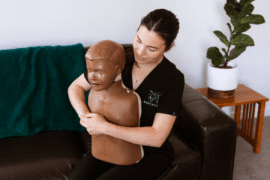By Kirsty Richards, Homeopath, DipHomNZ
Ask any woman who has experienced a miscarriage how they’d describe the experience, and “devastating” is a word they often use.
Whether it was a much-hoped-for pregnancy or a happy accident, once a woman knows she is pregnant – and if she wants to continue with the pregnancy – the oxytocin levels rise and bonding begins.
Sadly, about 10 to 20 percent of known pregnancies end in miscarriage. But the actual number is likely higher because many miscarriages occur so early in pregnancy that a woman doesn’t realise she’s pregnant.
A miscarriage usually happens in the first 3 months of pregnancy, before 12 weeks’ gestation. A small fraction of pregnancy losses – happening in less than 1% of pregnancies – are called stillbirths, as they happen after 20 weeks of gestation.
Many women can feel a huge sense of loss following a miscarriage.
Women often start bonding immediately with their babies and start envisaging this precious new life in their families. To hear their baby has passed away leaves a hole in their lives.
Not only do they have the emotional pain and loss to deal with, but often physical discomfort too.
Symptoms of miscarriage may include:
- Vaginal bleeding, which varies from light spotting to heavy bleeding
- Fluid, blood clots, or tissue passing from the vagina
- Abdominal pain or cramping
- Lower back pain
- Fever and chills
- No longer feeling the usual signs of pregnancy, such as breast tenderness and nausea
Miscarriage is an umbrella term, but there are various types of miscarriage:
Inevitable miscarriage
Inevitable miscarriages can come after a threatened miscarriage or without warning. There is usually a lot more vaginal bleeding and strong lower stomach cramps. During the miscarriage, your cervix opens and the developing foetus will come away in the bleeding.
Complete miscarriage
A complete miscarriage has taken place when all the pregnancy tissue has left your uterus. Vaginal bleeding may continue for several days. Cramping pain much like labour or strong period pain is common – this is the uterus contracting to empty.
If you have miscarried at home or somewhere else with no health workers present, you should have a check-up with a doctor or midwife to make sure the miscarriage is complete.
Incomplete miscarriage
Sometimes, some pregnancy tissue will remain in the uterus. Vaginal bleeding and lower abdominal cramping may continue as the uterus continues trying to empty itself. This is known as an ‘incomplete miscarriage’.
Missed miscarriage
Sometimes, the baby has died but stayed in the uterus. This is known as a ‘missed miscarriage’.
If you have a missed miscarriage, you may have a brownish discharge. Some of the symptoms of pregnancy, such as nausea and tiredness, may have faded. You might have noticed nothing unusual. You may be shocked to have a scan and find the baby has died.
It can be very distressing for a woman to be told her baby has passed away, yet the physical tissue is still present and she is waiting for it to pass. It can be a bittersweet experience of still “feeling pregnant” but knowing that it isn’t going to result in a live birth.











